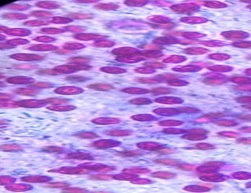The occurrence of cryptosporidiosis and amoebiasis among HIV infected female sex workers with symptomatic diarrhoea
Abstract
Objectives: Manipur is one of the high HIV prevalence states of India.Quite a good number of HIV infected females are indulged in the profession of sex workers. These female sex workers (FSWs) are experiencing a number of gastrointestinal related disorders including diarrhoea caused by a wide variety of pathogens, including parasites. Therefore, the present study is being undertaken with a view assessing the occurrence of enteric parasites, especially Cryptosporidium sp and Entamoeba histolytica towards their involvement as the diarrhoeagenic agent(s) in these groups of patients.
Materials and Methods: A cross-sectional study was conducted in the Department of Microbiology, Regional Institute of Medical Sciences (RIMS) Hospital, Imphal, Manipurfrom1stJanuary to 31stDecember 2018.The study group included54 HIVseropositive female sex workers with symptomatic diarrhoea. Stool sample(s) preserved in 2.5% K2Cr2O7for Cryptosporidium sp and 10% buffer formalin for Entamoeba histolytica and other classical parasites were collected for this study.
Results: The present study reveals that out of the selected 54 HIV positive FSWs screened for the presence of enteric parasitosis, 16 (29.62%) individuals were found positive for three parasitic infections– cryptosporidiosis, amoebiasis and hookworm infection. Both mixed infection (31.25%) and single infection (68.75%) were observed among the patients. Single infection with Cryptosporidium sp and Entamoeba histolytica were observed in 5 (31.25%) and 6 (37.5%) patients respectively. Patients in the age group of 25 -30 and 30-35 years were observed to have been more infected.
Conclusion: The study reveals that intestinal parasitic infection caused by Cryptosporidium sp and Entamoeba histolytica are prevalent among the present study group of HIV infected female sex workers.
Downloads
References
NACO, HIV Estimations,2017: Technical Report. New Delhi, NACO, Ministry of Health and Family Welfare, Government of India, National AIDS Control Organization and ICMR- National Institute of Medical Statistics. 2018. Available at http://naco.gov.in/sites/default/files/HIV%20Estimations%202017%20Report_1.pdf.
Cimerman S, Cimerman B and Lewis DB. Prevalence of intestinal parasitic infection inpatients with Acquired Immunodeficiency Syndrome in Brazil. Int J InfDis. 1999;3(4):203-206. doi: https://doi.org/10.1016/s1201-9712(99)90025-5.
Nath R, Saikia L, Sen SS, Borthakur AK. Clinical profile of HIV/AIDS in Assam Poster presentation (PM-10). Int Conf on Opportunistic. Pathogens in AIDS(ICOPA). New Delhi;2006:27-29.
Patel M, Patel R, Paliwal M. Intestinal parasitic infections in HIV-1 seropositive individuals and its correlation with CD4 cell count in a tertiary care teaching hospital, Gujarat. Int J Biomed Adv Res. 2017;8(4):174-178. doi: https://doi.org/10.7439/ijbar.v8i4.4114.
Anand L, Brajachand Ng, Dhanachand Ch. Cryptosporidiosis in HIV infection.JComm Diseases.1996;28(4):241-244.
Anand L, Dhanachand Ch, Brajachand Ng. Prevalence and epidemiologic characteristics of opportunistic and non-opportunistic intestinal parasiticinfections inHIV positive patients in Manipur. J Comm Diseases.1998;30(1):19-22.
Agarwal A, Ningthouja S, Sharma D, Mohen Y and Singh NgB. Cryptosporidiumand HIV.J Ind Med Assn. 1998;96(9):276 -277.
Dhanachand Ch, Anand L. Helminthic infections in HIV/AIDS patients, In Helminthology in India; Edited by Prof. M.L. Sood,International Book Distributors, Dehradun, India; 2003.
Singh LA, Das SC, Baruah I. Enteric parasites in patients with HIV infection. JParasitol AppAnimal Biol. 2004a;13(1 and 2):55-64.
Singh LA, Chinglensana L, Singh Ng B, Singh HL, Singh YI. Helminthiasis in HIV infection: A brief report from Manipur (India). J Comm Diseases. 2004b;36(4):293-296.
Devi PP, Rebachandra H, Brajachand SN, Nabakumar TH. Strongyloides stercoralis infection in an HIV positive patient – A case report from RIMS, Imphal, Manipur. J Comm Diseases.2010;42(3):231-234.
Singh Th N, Devi H R, Singh L A. Occurrence of Hookworm-Whipworm co-infection among the HIV/AIDS patients of Noney district of Manipur, India. IOSR J Dent Med Sci. 2018;17(10):15-18.
World Health Organization (WHO). Bench Aids for the diagnosis of intestinal parasites, Reprinted copy, Geneva; 2003a. Available at https://apps.who.int/iris/handle/10665/37323.
World Health Organization (WHO). Manual of basic techniques for a health laboratory, 2nd Edition, Geneva;2003b. Available at https://apps.who.int/iris/bitstream/handle/10665/42295/9241545305.pdf;jsessionid=005E1834EF6EA29A669131B7A5DCAEDA?sequence=1.
John D T and Petri Jr, W A. Examination of stool specimens (Chapter 14),In Markell and Voge’s Medical Parasitology. 9th Edition, Elsevier;2009:pp 407-408.
Smith H V. Intestinal Protozoa, In Medical Parasitology, A Practical Approach, Edited by Gillespie, S.H. andHawkey, P. M. Oxford University Press, Reprinted. 2002;pp 79-117.
Talib S H, Singh J. A study on opportunistic enteric parasites in HIV seropositive patients. Ind J Pathol Microbiol. 1998;41(1):31-37.
Mukhopadhya A, Ramakrishna B S, Gangadeep K, Pulimood AB, Mathan MM, Zachariah A. Enteric pathogens in Southern Indian HIV infected patients with and without diarrhoea, Ind J Med Res. 1999;109:85-89.
EscobedoA A, Nunez FA. Prevalence of intestinal parasites in Cuban acquired immunodeficiency syndrome (AIDS) patients. Acta Tropica.1999;72(1):125-130. doi: https://doi.org/10.1016/s0001-706x(98)00091-6.
Bajaj R, Arora U, Aggarwal A. Prevalence of intestinal protozoa in HIV seropositive patients with special reference to Cryptosporidiosis.J Parasitic Diseases. 2003;27(1):29-32.
Misra SN, Sengupta D and Satpathy SK. AIDS in India: Recent trends in opportunistic infection: South East Asian JTrop MedPublic Health. 1998;29(2):373-376.
NavinTR, Weber R, Vugia,DJ,Rimlan D, RobertsJM, Addis DG, et al.Declining CD4 T-lymphocyte counts areassociated with Increased risk of enteric parasitosis and chronic diarrhea: Results ofa 3-year longitudinal study. J AIDS Human Retrovirol. 1998;20(2):154-159. doi: https://doi.org/10.1097/00042560-199902010-00007.
WeberR, LedergerberB, ZbindenR, Altwegg M,PfyfferGE, SpycherMA,et al. Enteric infections anddiarrhea in human immunodeficiency virus infected persons ArchIntern Med. 1999;159(13):1473-1480. doi: https://doi.org/10.1001/archinte.159.13.1473.

Copyright (c) 2020 Author (s). Published by Siddharth Health Research and Social Welfare Society

This work is licensed under a Creative Commons Attribution 4.0 International License.


 OAI - Open Archives Initiative
OAI - Open Archives Initiative


